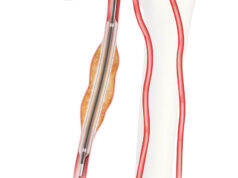
Biotronik has announced one-year subgroup results from the investigator-initiated BIOPACT randomised controlled trial (RCT), which were presented by principal investigator Koen Deloose (AZ Sint-Blasius, Dendermonde, Belgium) at this year’s Leipzig Interventional Course (LINC 2023, 6–9 June, Leipzig, Germany).
The randomised controlled non-inferiority trial evaluated the safety and efficacy of the Passeo-18 Lux drug-coated balloon (DCB) catheter compared to the In.Pact Admiral DCB (Medtronic) and showed excellent results for both balloons through 12 months across a variety of sub-cohorts, Biotronik reports.
The prospective, multicentre, core lab-adjudicated non-inferiority study enrolled 302 patients in Austria, Belgium, France and Switzerland with Rutherford 2-4 disease. Patients were randomised 1:1 to either the Passeo-18 Lux DCB or In.Pact Admiral DCB for the treatment of stenotic, non-stented restenotic or occlusive lesions in the femoropopliteal artery.
The primary safety endpoint was a composite of freedom from device- and procedure-related death through 30 days post-index procedure, freedom from major target limb amputation and clinically driven target vessel revascularisation through 12 months post-index procedure. It showed no statistically significant difference between balloons for the full data set and across subgroups:
- Diabetes: 94.7% vs. 95.2% (Passeo-18 Lux DCB vs. In.Pact Admiral DCB in diabetics); 97.1% vs. 95.6% (Passeo-18 Lux DCB vs. In.Pact Admiral DCB for non- diabetics)
- Lesion length: 95.9% vs. 90% (Passeo-18 Lux DCB vs. In.Pact Admiral DCB, respectively, for patients with target lesions ≥100 mm); 96.7% vs. 97.9% (Passeo-18 Lux DCB vs. In.Pact Admiral DCB for patients with target lesions <100 mm)
- Calcium: 98.1% vs. 96.8% (Passeo-18 Lux DCB vs. In.Pact Admiral DCB, respectively, in severely calcified lesions); 92.9% vs. 89.7% vs (Passeo-18 Lux DCB vs. In.Pact Admiral DCB in none/moderately calcified lesions)2.
- Bailout stenting: 100% vs. 100% (Passeo-18 Lux DCB vs. In.Pact Admiral DCB, respectively, with bailout stenting); 96.1% vs. 95% (Passeo-18 Lux DCB vs. In.Pact Admiral DCB without bailout stenting)2.
- Occlusions: 100% vs. 100% (Passeo-18 Lux DCB vs. In.Pact Admiral DCB, respectively, in occlusions); 95.8% vs. 94.7% (Passeo-18 Lux DCB vs. In.Pact Admiral DCB in stenoses)
“Interestingly, we found that across all variations and cohorts, there was no statistically significant difference in safety, primary patency, or clinically driven target lesion revascularisation,” said Deloose. “There is a scarcity of randomised head-to-head data, especially in the drug-coated balloon space, so the more data we have available, the more answers we have.”
One-year results from the full cohort, presented last year at Paris Vascular Insights 2022, showed comparable results between treatment arms, with a freedom from clinically driven target lesion revascularisation rate of 97.2% for Passeo-18 Lux DCB and 97.0% for In.Pact Admiral DCB (p=0.0002).
A press release details that the Passeo-18 Lux DCB has a paclitaxel dose of 3.0 µg/mm2 and uses a Butyryl-tri-hexyl citrate excipient (In.Pact Admiral DCB: 3.5 µg/mm2 and urea excipient). The lower-profile Passeo-18 Lux DCB is on an 0.018″ platform and is 4Fr compatible for diameters of 2–mm and 5Fr compatible for diameters of 5–7mm. In comparison, the release continues, the In.Pact Admiral DCB is 5F compatible only for its 4mm diameter, and is 6Fr or 7Fr compatible for its diameters of 5–7mm.
The BIOPACT study will continue collecting follow-up data at 24, 36, 48 and 60 months, which will be shared upon completion of each follow-up period. Biotronik advises that the 24-month full-cohort results will be announced later this year.













